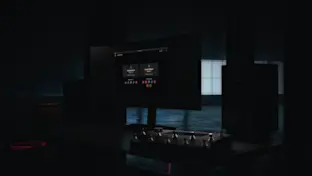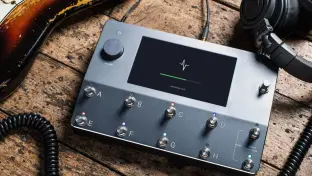
CorOS 1.2.0 is now available

CorOS 1.2.0 is now available. Download it via Settings > Device Options > Device Updates on your Quad Cortex once connected to Wi-Fi. We recommend that you create a backup before updating your firmware.
CorOS 1.2.0 includes four new amplifiers, two cabinets, a fuzz, two overdrives, and four reverbs, alongside a handful of new features, changes, and bug fixes. We have also increased the local Capture and IR slots from 256 to 1024.
Read the changelog for the full list of changes.
Pickup level - a unique approach to input impedance and its interaction with Fuzz
Adding Facial Fuzz, a new Fuzz algorithm based on the legendary Dallas Arbiter™ Fuzz Face™, presented a unique challenge. Pedals with low input impedance, like the Fuzz Face™, have a strong interaction with the guitar’s pickups and volume control. With digital models of such pickups, that interaction is interrupted; the guitar pickup doesn’t “see” the fuzz pedal, and likewise the fuzz pedal doesn’t “see” the pickup.
To address this problem, we have included pickup and volume controls, Pickup Switch and Pickup Level, at the input of the Facial Fuzz. With this, the model’s signal is fed from a source that mimics the behaviour of guitar pickup circuitry.
The Pickup Level control can be thought of as an external guitar volume control. You can set it lower for cleaner tones or all the way up for maximum fuzz effect. Another way to use it is to set it around 8.0 - 9.0 and use your guitar’s volume potentiometer to adjust the amount of fuzz.
Set the Pickup Switch to match your guitar’s pickups. If you have a guitar with single coil pickups, such as Stratocaster or Telecaster, choose “Single”. With humbucker equipped guitars such as Les Paul, choose “HB”. Two different switch positions yield different tonality and different levels of gain. For that reason you can also try mismatching the Pickup Switch.
Four new Reverbs and a new approach to algorithm design
CorOS 1.2.0 incorporates three new Plate Reverb algorithms: Plate, Plate Lush, and Plate Tight, as well as an interesting variation of a hall reverb; Mind Hall. Despite having the sonic characteristics of a physical space, Mind Hall is not based on any real one. It also provides infinite decay capabilities, ideal for recreating freeze-style effects.
To implement these new Reverbs, we experimented with a different algorithm design approach.
We have been working for a long time on a new engine based on an All-pass Filter Ring, which has many advantages to Feedback Delay Networks (FDNs) for embedded applications. These techniques have been used for many years, with Lexicon® having some of the most noteworthy reverbs implemented this way. They are incredibly efficient, but have the added challenge that fine tuning them is considerably more involved than with the more commonly used FDNs.
This is due to their unconventional topology; these algorithms are full of “golden numbers”, many of which are still kept a secret, so the literature on them is rare and limited. They also have an extremely high number of parameters, which have to be dialed in perfectly in order to obtain a natural, smooth-sounding reverb; a process that at times felt closer to black magic than science.
After a lot of time fine tuning, we are extremely proud of these four incredibly lush new reverbs, which also happen to be extremely efficient in their CPU and memory requirements.
Changelog
Added
New amps:
Bogna Vishnu 20th Clean
Captain 50
EV101IIIS Blue 6L6 100W
EV101IIIS Red 6L6 100W
New cabs:
212 US TWN CK2
412 Watt S4123
New overdrives:
Exotic Z Boost
Exotic Bass Z Boost
Facial Fuzz
New reverbs:
Mind Hall
Plate
Plate Lush
Plate Tight
A notification icon displays next to the Main Menu and on the Settings page when a new CorOS update is available.
A warning message will display if you try to download a Preset that is not compatible with your current version of CorOS (for example, if the Preset uses devices that are not available in your current version).
Changed
USB inputs have been renamed. “From Out 1” is now “USB Output 3 (Grid)” and “From Out 2” is now “USB Output 4 (Grid)”.
Local Neural Capture storage has been increased from 256 slots to 1024 slots.
Local Impulse Response storage has been increased from 256 slots to 1024 slots.
Neural Capture sanity check messages have been rephrased to be more informative.
Multi-Out is now the default Output option when creating a Neural Capture.
Fixed
The Tuner correctly functions at frequencies other than 440Hz.
The Undo & Redo buttons now correctly undo/redo a device change when a block on The Grid is changed via the contextual menu.
Splitters can now have their type changed in scenes.
The “Download All” button no longer displays on the Cloud > IRs folder when there are no IRs to download.
Scene-assigned Splitter parameters are no longer lost when changing scenes via footswitches while the Splitter type parameter is being modified.
Double-tapping the MAX RANGE % parameter on the expression pedal configuration screen now correctly resets the value to default.
An issue where expression pedal 2 would modify the UI value of the top-left parameter controlled by expression pedal 1.
An issue where pressing a footswitch while simultaneously dragging-and-dropping a block could cause a crash.
Sweeping an expression pedal assigned to multiple parameters no longer causes an error during the Neural Capture sanity check.
The bypass state of a block saved in a Preset is now recalled when unplugging an expression pedal assigned to the block.
Tape Delay trails are now maintained when changing the bypass state of a Tape Delay block via scenes.
A bug in which the Adaptive Gate would not function correctly when placed before certain drive effects.
Several minor backend fixes and optimizations.

